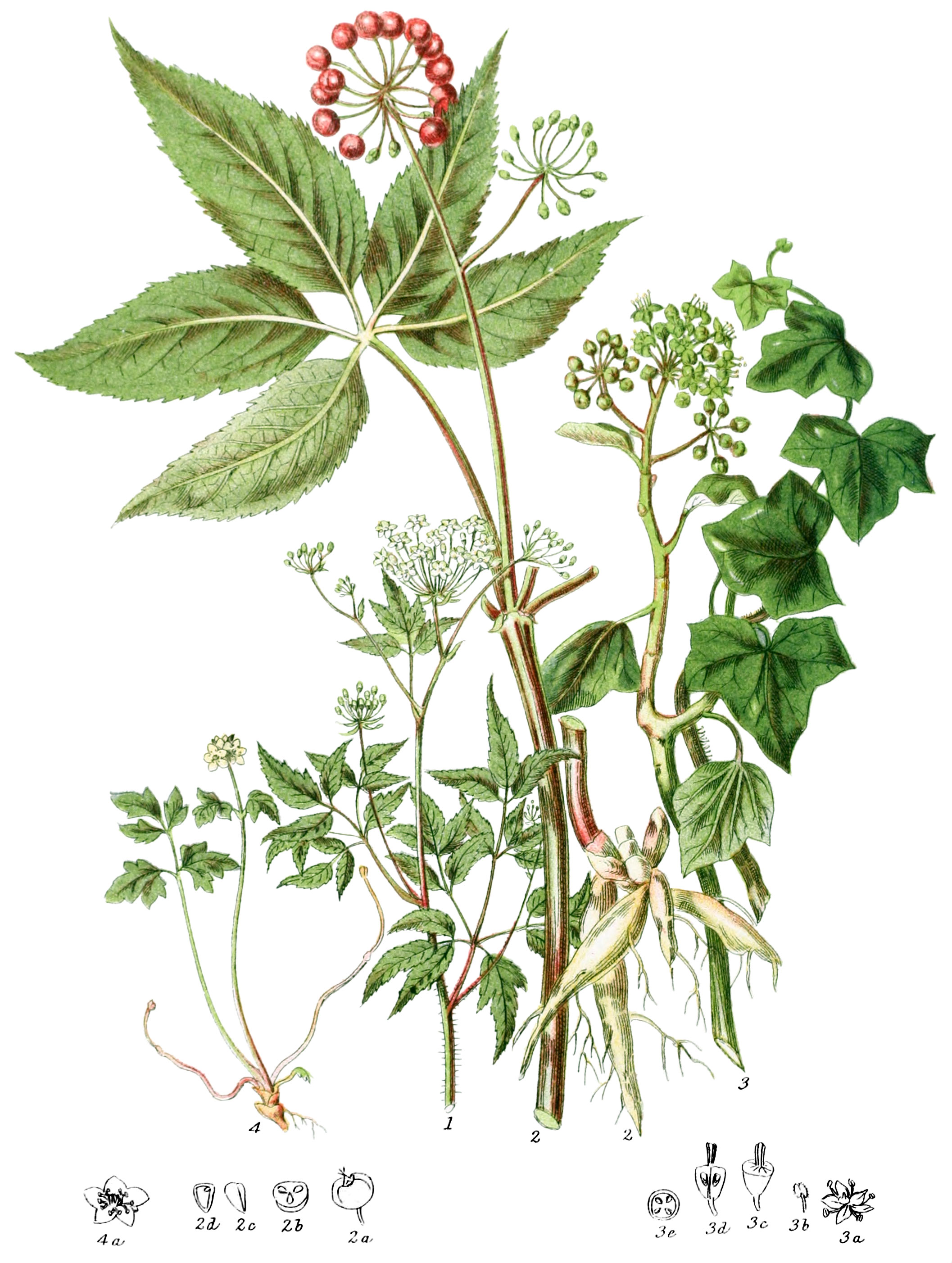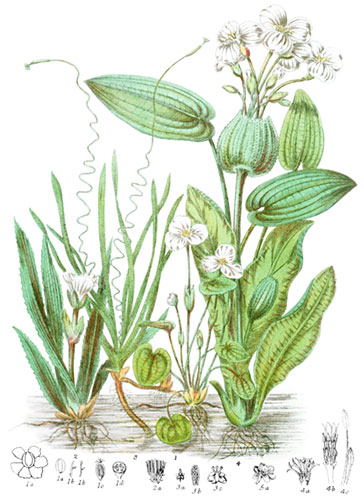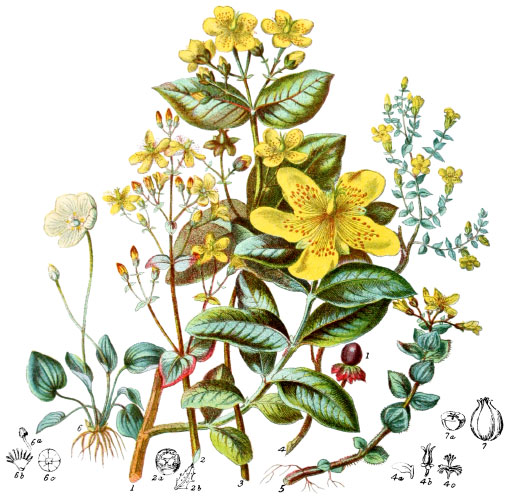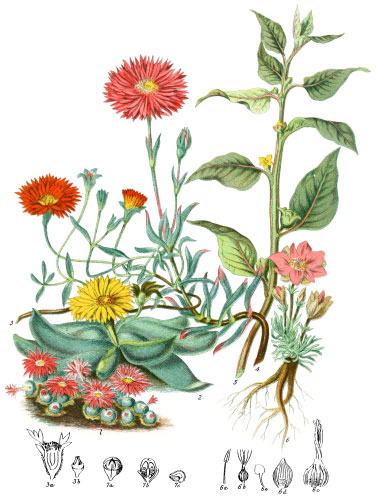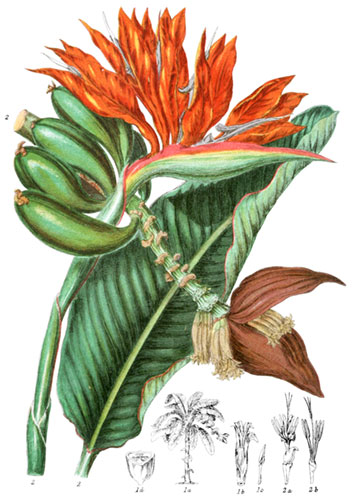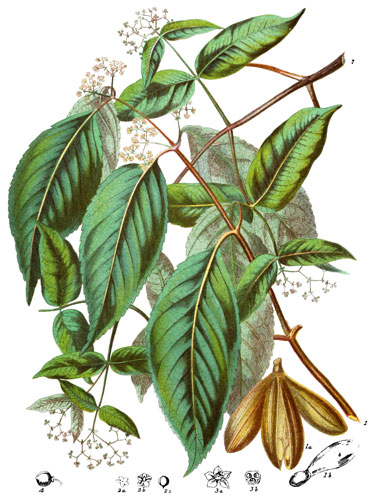Key characteristics
Trees, shrubs, and herbaceous plants; the leaves are alternate, usually divided or compound, sometimes lobed or simple; the leaf-stalks are widened at their base. The flowers grow in umbels at the ends of the branches, usually surrounded by a few small leaflets in an involucre, or from the base of the leaf-stalk. The petals are two, five, or ten, occsionally wanting. The stamens are either equal in number to the petals, or twice as many, growing between the border of the calyx and the disk. The ovary is below the calyx, having more than two cells; the styles are of the same number as the cells, sometimes united together; the stigmas are simple. The fruit is succulent, or dry, consisting of several cells, each with a solitary seed, which contains albumen.
The plants have considerable affinity with Ubellaceæ, but are readily distinguished by the fruit having more than two cells. Hedera forms a link with Viburnum, in the Honeysuckle tribe.
Select plants in this order
Not all plants listed are illustrated and not all plants illustrated are listed.
- The properties are generally aromatic and stimulant: gum-resin occasionally exists in the root. Aralia was first brought from Virginia in 1688; several spieces have been since found in North America and New Zealand.
- Aralia polaris was discovered by Dr. Joseph Hooker, in Lord Auckland’s Isles in the South Ocean.
- Some species have remarkably near foliage, the leaves of others resemble those of the common Umberlliferous plants, to which in habit and manner of growth they are so closely allied.
- A. hispida (1) is a low shrub found by Michaux, on steep rocky mountains, between Canada and Hudson’s Bay; the lower part of the stem is clothed with rigid hairs; when bruised, the plant is bitter and nauseious, but it yields an aromatic gum-resin from its root, similar to that obtained from A. racemosa and A. spinosa.
- The young shoots of A. nudicaulis are used medicinally in North America.
- The petals of A. palmatum and a few other species cohere at their points; some of these plants are of a climbing nature; a few are parasitic in their manner of growth.
- Panax quinquefolium, the famous Ginsent, or “wonder of the earth,” of China and tartary, was anciently supposed to contain in its aromatic root a remedy for all diseases; in more modern times, the Chinese seem to have used it also as a preservative of health; for Osbeck, the traveller, relates that they take it daily in tea and in soup. Owing to its imagined medicinal value, and the difficulty of obtaining it from the almost inaccessible places where it grows, it has been said to have cost its weight in gold. This extraordinary plant is also a native of North America, and is employed by the Canadians as a cure for asthma.
- Panax pseudo-ginseng (2) resembles it in appearance, but the aromatic properties of the root are inconsiderable, the mucilaginous substance being very nearly scentless. It is found on the mountains of Sheopore, in Nepal, at an elevation of 9000 feet above the plains, in the shade of Oaks and Rhododendrons. Several other species belong to the mountain ranges of India, generally between 2000 and 3000 feet; some grow on wet mossy banks in the valleys at 6000 feet. A few are shrubs with strong spines, others are smooth; the flowers are usually small, pale yellow or white.
- One species in Bootan is a low tree, having the habit of a Palm, the simple straight stem rising to about twenty feet, the leaf-stalks beset with strong straight spines.
- P. pusilla is a native of Pennsylvania, bearing its little umbel of greenish white flowers on a stalk only eight inches high.
- On the Campos of Brazil, a species of considerable size is frequent.
- Hedera Helix (3) was highly esteemed by the Romans, and adopted as a suitable plant for a poet’s crown. The name is supposed to have been erived from the Celtic word hedra, cord, which the rough stems wound round other trees exactly resemble. No other plant contributes so much to the ornament of bare walls or old ruins, and the climate of Britain is peculiarly favourable to its luxuriant growth. The flowers appear in October, when they afford acceptable food to bees and flies; the fruit is not mature until the following spring.
- A variety, called Irish Ivy, although a native of Madeira, grows with grat rapidity, and is more brilliant foliage. In the countries bordering the Mediterranean, a kind of resin exudes from old stems of Ivy, and is used as gum, having an agreeable odour when burned.
- H. polycantha of Nepal is spiny on the stems and branches; the palmate leaves are ten inches long, giving it more the aspect of Panax than of common Ivy.
- H. rotundifolia grows in Japan; H. ternata, in Brazil; H. arborea, in Jamaica.
- In Hong Kong are found H. parviflora and H. protea.
- Adoxa moschatellina (4) is a delicate little plant of lowly growth, rare in England, but occasionally seen on sheltered banks and in copses, about the end of April, before a thicker vegetation conceals it; the fruit becomes a pulpy berry in ripening.
Locations
These plants are dispersed in the Tropics and neighbouring regions, as well as in cold countires: some exist in the United States, in Canada, on the north-west coast of America, and in Japan. Aralia polaris is found in Lord Auckland’s Isles, in 50° of south latitude.
Legend
- Aralia hispida, Bristly Aralia. North America.
- Panax pseudo-ginseng, Indian Ginseng. Himalayas.
- Fruit.
- Cross section.
- Seed.
- Section.
- Hedera Helix, Common Ivy. Britain.
- Flower.
- Stamen.
- Pistil and Ovary.
- Section.
- Cross section.
- Adoxa moschatellina, Tuberous Moschatell. England.
- Flower, magnified.
Explore more
Posters
Decorate your walls with colorful detailed posters based on Elizabeth Twining’s beautiful two-volume set from 1868.
Puzzles
Challenge yourself or someone else to assemble a puzzle of all 160 botanical illustrations.
